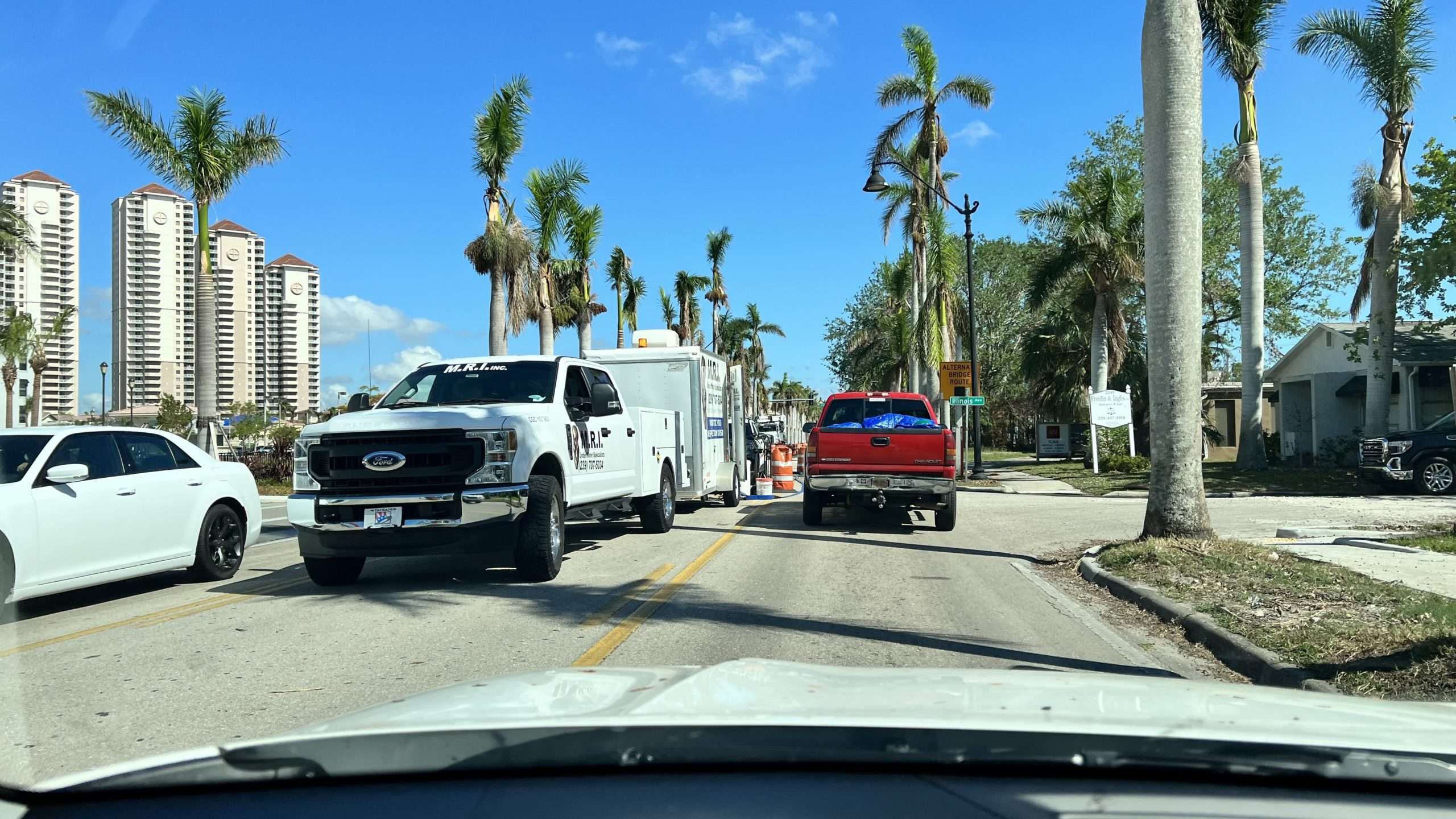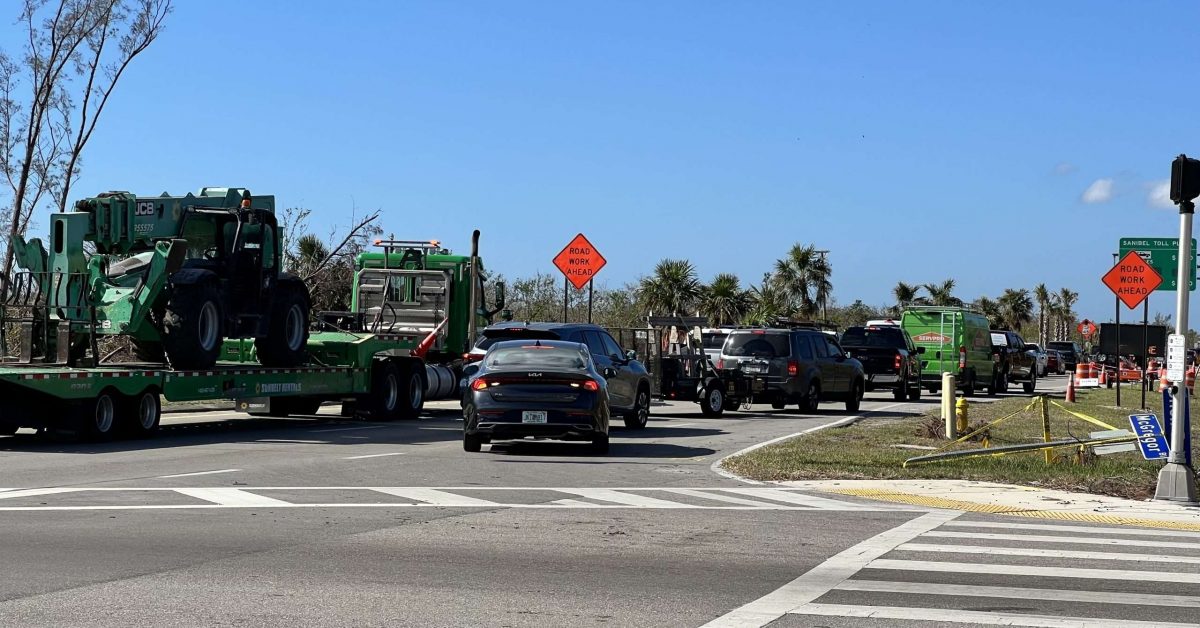Packed roads and filled hotels are creating a new kind of post-Hurricane Ian world in Southwest Florida, especially in Lee County.
Since the Sept. 28 storm, roads have been clogged just about everywhere, and not only during rush hour, for a variety of reasons.
In Lee County, where coastal communities in Fort Myers Beach, Sanibel and Captiva islands, Pine Island, Matlacha and parts of Cape Coral received widespread devastation, about 20,000 homes received major damage from winds and storm surge. This has diverted many displaced residents into the mix with the regular flow of traffic.
Combine that with the onset of seasonal traffic, along with a litany of construction contractors, roofing companies, electrical workers, mold mitigation businesses and an increased presence of law enforcement, and it makes for slow-going, especially during the morning and late afternoon throng of rush-hour traffic that’s further loaded with usual commuters.
The Florida Highway Patrol, for example, dispatched an additional 90 patrol cars to the region to assist with excess traffic.
Lee County provided data from Oct. 18 of this year, a Tuesday, as compared to the same date last year, a Monday. Pine Island Road in Cape Coral, east of Del Prado Boulevard, had 32,281 vehicles per day, which is 9% higher than the same date one year prior and 7% higher than peak seasonal traffic in March.
Meanwhile, Colonial Boulevard west of Plantation Road in Fort Myers had 61,680 vehicles per day, which is 6.75% higher than last year.
U.S. 41, north of Estero Parkway, had 60,990 vehicles per day, which is 9% higher.
Martin Luther King Jr. Boulevard in Fort Myers, east of Ortiz Avenue, had 55,367 vehicles per day, which was 3% higher.
John Lai, president of the Sanibel Captiva Chamber of Commerce, said the Sanibel Causeway was experiencing seasonal traffic levels, about 10,000 vehicles per day, as soon as it reopened. 
“I think you’re going to see more of the same,” said Stan Stouder, a founding partner with CRE Consultants. “I live right by the Sanibel Causeway now. I saw 50 dump trucks at 7:30 at night doing 60 to 70 miles an hour off Summerlin Road. They were just feeding materials to Sanibel. It looked like Alico Road, but they were hauling materials down to the causeway.
“My thinking is, you can’t import all of these contractors, FEMA guys, etc., without having that density of traffic. I think you’re going to see the tourism dollars with the outgoing tide. The incoming tide will be contractors bringing in that revenue for the community.”
All of those visiting contractors and construction workers need places to stay, and area hotel rooms have been at or near 100% occupancy for the past month.
There were about 13,000 Lee County hotel rooms prior to Hurricane Ian, according to county data. Post-storm numbers aren’t available, but Sanibel and Captiva combine to have about 250 hotel properties.
Betsy Clayton, Lee County director of communications, declined to allow Tamara Pigott, director of Lee County Visitor/Conventions Bureau, to speak with Gulfshore Business about the short-term future of tourism in Lee County. But hotel owners in the coastal areas have told Gulfshore Business they do not expect large-scale tourism to return until 2024.
With Lee County rooms scarce and demand high, the average daily rate for those rooms rose from $131.01 the week of Oct. 8-15, 2021 to $158.15 for the same dates this year, an increase of 20%, according to Lee County.
In Collier County, the trends diverged from Lee County. For the week of Oct. 9-15, the average daily room rate was $214.32 this year, a 4.9% decrease from $224.90 last year. But one week later, Oct. 16-22, the average daily room rate rose from $225.08 a year ago to $230.73 this year, a 2.5% increase.
Collier County has about 10,000 hotel rooms and fared much better than Lee County from the storm, said Paul Beirnes, executive director of Collier County’s visitor and convention bureau.
“Right off the bat, it’s certainly an escalated response by first responders, construction contractors and displaced residents,” Beirnes said. “It put everyone in an immediate overnight pinch.”
The day after Hurricane Ian made landfall, the Collier VCB began making a round of calls to 115 hotels, reaching about 30% of those properties for status reports.
“Fast forward, every day gets better and better,” Beirnes said. “This weekend, when we crunched the numbers, about 80% of all rooms are open for business. It’s starting to normalize a little bit.”
While coastal Lee County hotels most certainly will not have a 2023 tourist season, Collier County hotels will, Beirnes said.
“If you had asked me that a week ago, it seems like every day, you can soften the tone,” Beirnes said. “Things are changing remarkably quickly.
“A week ago, I would have said the hotels are going to be 100% full of contractors and responders and vendors.”
Now, Beirnes said his thinking is shifting. “I have a feeling there will be a season,” he said of 2023. “There’s a passion and desire for tourists to come to this destination. I really do believe these hotels are opening up so fast. It may look different. But I think we’re going to have a season. It just won’t look or feel anything like normal. But we will have some visitors here, no question about it.”
If Beirnes is right, Southwest Florida traffic in January through March of 2023 could grow even more intense than it is now.
Lt. Greg Bueno with the Florida Highway Patrol leads the communications division and urged drivers to use extra caution.
“Whether we have 1,000 cars on the road or a million, people have to have patient,” Bueno said. “If they want a good way to get themselves in trouble – road rage – you injure someone, you’re going to be held accountable. And it’s just not worth it. People need to keep themselves in check.”





